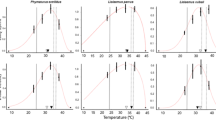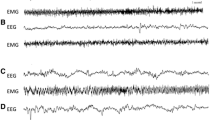Summary
-
1.
Physiological factors relating to activity metabolism were measured in two species of African lacertid lizards that differ greatly in natural foraging patterns:Eremias lineoocellata, a sit-and-wait predator, andE. lugubris, a widely foraging animal.
-
2.
Maximal oxygen consumption at 37°C is greater inE. lugubris [3.22 ml O2/(gxh)] than inE. lineoocellata [2.49 ml O2/(gxh)].
-
3.
Anaerobic scope and capacity at 37°C are greater inE. lineoocellata [2.56 mg lactate/(gx min) and 1.81 mg lactate/g] than inE. lugubris [2.12 mg lactate/(gxmin) and 1.40 mg lactate/g].
-
4.
Relative heart mass and hematocrit are greater inE. lugubris than inE. lineoocellata (0.28% and 0.24% body mass; 30.1 and 24.4 respectively).
-
5.
No significant interspecific differences occur in hind limb muscle mass as a percentage of body mass or in myoglobin concentration, citrate synthase or myofibrillar ATPase activity of hind limb skeletal muscle.
-
6.
No significant interspecific differences occur in isometric contractile properties (twitch and tetanic tension, twitch rise time and half-relaxation time, and fatigue response to tetanic stimulation) of the iliofibularis muscle.
-
7.
Organismal metabolic patterns of aerobic and anaerobic capacity reflect differences in locomotor capacity and natural foraging patterns of these species.
Similar content being viewed by others
References
Bárány M (1967) ATPase activity of myosin correlated with speed of muscle shortening. J Gen Physiol 50:197–218
Bartholomew GA (1964) The roles of physiology and behaviour in the maintenance of homeostasis in the desert environment. Symp Soc Exp Biol 18:7–29
Bennett AF (1972) A comparison of activities of metabolic enzymes in lizards and rats. Comp Biochem Physiol [B] 42:637–647
Bennett AF (1980) The metabolic foundations of vertebrate behavior. Bioscience 30:452–456
Bennett AF, Licht P (1972) Anaerobic metabolism during activity in lizards. J Comp Physiol 81:277–288
Bennett AF, Ruben JA (1979) Endothermy and activity in vertebrates. tebrates. Science 206:649–654
Bennett AF, Huey RB, John-Alder HB, Nagy KA (1982) Activity physiology and behavioral capacity of two congeneric lizards. Physiologist 25:338
Castellini MA, Somero GN (1981) Buffering capacity of vertebrate muscle: Correlations with potentials for anaerobic function. J Comp Physiol 143:191–198
Cole RP (1982) Myoglobin function in exercising skeletal muscle. Science 216:523–525
di Prampero PE (1981) Energetics of muscular exercise. Rev Physiol Biochem Pharmacol 89:143–222
Else PL, Hulbert AJ (1981) Comparison of the “mammal machine” and the “reptile machine”: Energy production. Am J Physiol 240 (Reg Integ Comp Physiol 9): R3-R9
Gleeson TT (1979) The effects of training and captivity on the metabolic capacity of the lizardSceloporus occidentalis. J Comp Physiol 129:123–128
Gleeson TT, Mitchell GS, Bennett AF (1980) Cardiovascular responses to graded cctivity in the lizardsVaranus andIguana. Am J Physiol 239 (Reg Integ Comp Physiol 8):R174-R179
Hemmingsen EA (1963) Enhancement of oxygen transport by myoglobin. Comp Biochem Physiol 10:239–244
Holloszy JO (1973) Biochemical adaptations to exercise: Aerobic metabolism. Exercise Sport Sci Rev 1:45–71
Holloszy JO, Booth FW (1976) Biochemical adaptations to endurance exercise in muscle. Annu Rev Physiol 28:273–291
Holloszy JO, Oscai LB, Don IJ, Mole PA (1971) Mitochondrial citric acid cycle and related enzymes: Adaptive response to exercise. Biochem Biophys Res Commun 40:1368–1373
Huey RB (1982) Temperature, physiology, and the ecology of reptiles. In: Gans C, Pough FH (eds) Biology of the Reptila, vol 12. Academic Press, New York, pp 25–91
Huey RB, Pianka ER (1981) Ecological consequences of forgaging mode. Ecology 62:991–999
Huey RB, Pianka ER, Hoffman JA (1977) Seasonal variation in thermoregulatory behavior and body temperature of diurnal Kalahari lizards. Ecology 58:1066–1075
Huey RB, Bennett AF, John-Alder HB, Nagy KA (1983) Locomotor capacity and foraging behaviour of Kalahari lacertid lizards. Anim Behav (in press)
Marsh RL, Wickler SJ (1982) The role of muscle development in the transition to endothermy in nestling bank swallows,Riparia riparia. J Comp Physiol 149:99–105
Nagy KA, Huey RB, Bennett AF (1984) Field energetics and foraging mode of Kalahari lacertid lizards. Ecology (in press)
Pianka ER (1971) Lizard species density in the Kalahari desert. Ecology 52:1024–1029
Pough FH (1980) The advantages of ectothermy for tetrapods. Am Nat 115:92–112
Putnam RW, Gleeson TT, Bennett AF (1980) Histochemical determination of the fiber composition of locomotory muscles in a lizard,Dipsosaurus dorsalis. J Exp Zool 214:303–309
Regal PJ (1978) Behavioral differences between reptiles and mammals: An analysis of activity and mental capacities. In: Greenberg H, MacLean PD (eds) Behavior and neurobiology of lizards. Department of Health, Education, and Welfare, Washington, DC, pp 67–115
Reynafarje B (1963) Simplified method for the determination of myoglobin. J Lab Clin Med 61:138–145
Ruben JA (1976a) Aerobic and anaerobic metabolism during activity in snakes. J Comp Physiol 109:147–156
Ruben JA (1976b) Correlation of enzymatic activity, muscle myoglobin, concentration and lung morphology with activity metabolism in snakes. J Exp Zool 197:313–320
Ruben JA, Battalia DE (1979) Aerobic and anaerobic metabolism during activity in small rodents. J Exp Zool 208:73–76
Saltin B (1973) Oxygen transport by the circulatory system during exercise in man. In: Keul J (ed) Limiting factors of physical performance. Thieme, Stuttgart, pp 235–252
Shephard RJ (1976) Cardio-respiratory fitness. A new look at maximum oxygen intake. In: Jokl E, Anaud RL, Stoboy H (eds) Advances in exercise physiology. Karger, Basel, pp 61–84
Srere PA (1969) Citrate synthase. Methods Enzymol 13:3–5
Taigen TL, Emerson SB, Pough FH (1982) Ecological correlates of anuran exercise physiology. Oecologia (Berl) 52:49–56
Author information
Authors and Affiliations
Rights and permissions
About this article
Cite this article
Bennett, A.F., Huey, R.B. & John-Alder, H. Physiological correlates of natural activity and locomotor capacity in two species of lacertid lizards. J Comp Physiol B 154, 113–118 (1984). https://doi.org/10.1007/BF00684134
Accepted:
Issue Date:
DOI: https://doi.org/10.1007/BF00684134




